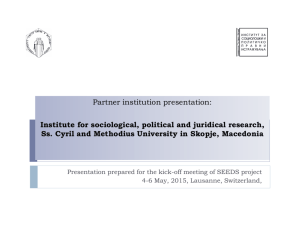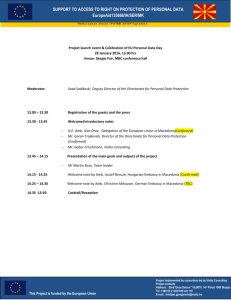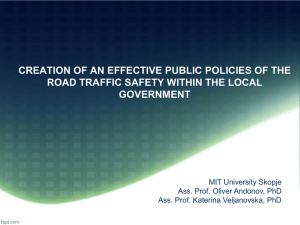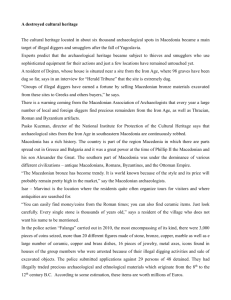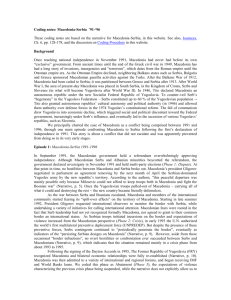No. 44
advertisement
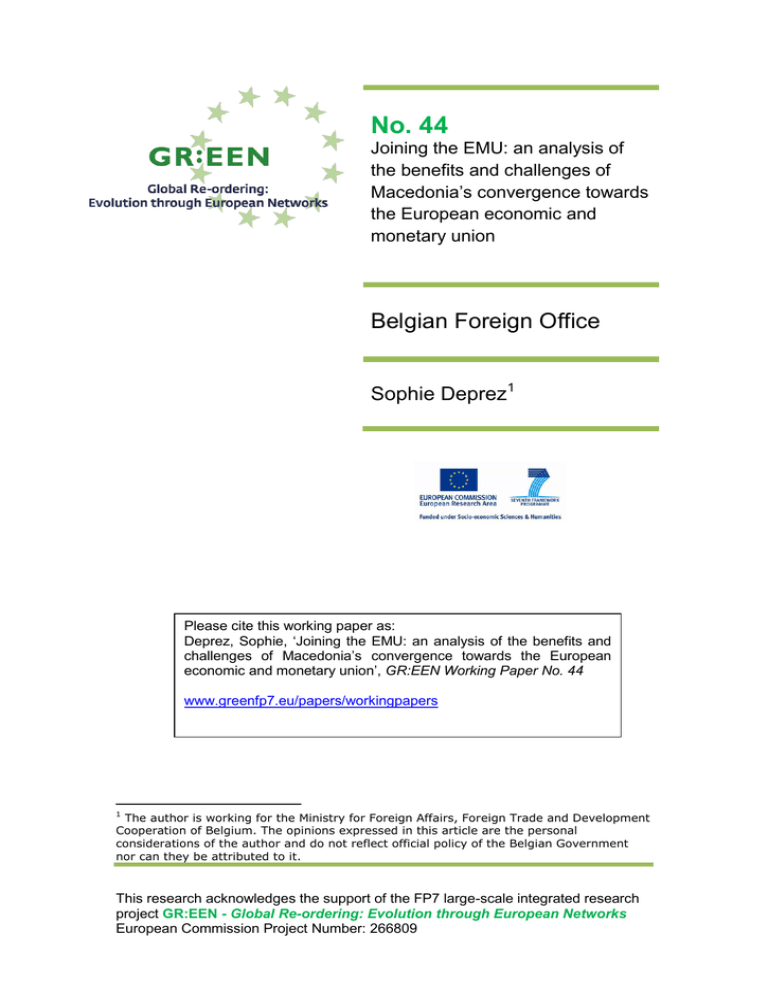
No. 44 Joining the EMU: an analysis of the benefits and challenges of Macedonia’s convergence towards the European economic and monetary union Belgian Foreign Office Sophie Deprez1 Please cite this working paper as: Deprez, Sophie, ‘Joining the EMU: an analysis of the benefits and challenges of Macedonia’s convergence towards the European economic and monetary union’, GR:EEN Working Paper No. 44 www.greenfp7.eu/papers/workingpapers 1 The author is working for the Ministry for Foreign Affairs, Foreign Trade and Development Cooperation of Belgium. The opinions expressed in this article are the personal considerations of the author and do not reflect official policy of the Belgian Government nor can they be attributed to it. This research acknowledges the support of the FP7 large-scale integrated research project GR:EEN - Global Re-ordering: Evolution through European Networks European Commission Project Number: 266809 Abstract2 This paper offers an evaluation of Macedonia’s readiness to join the European common currency rapidly after accession to the European Union. The key question addressed is how soon after EU accession will Macedonia meet the critical lower threshold in the mix of OCA properties for endogeneity effects to appear ? The paper examines firstly whether pegging its currency to the euro and eventually joining the EMU is an adequate policy objective, bringing benefits for Macedonia. After that, the paper takes a look at Macedonia’s performance in the five formal convergence criteria. Finally, the paper examines whether Macedonia is able to deal with temporary and permanent asymmetric shocks. We look at business cycle correlation, labour market rigidities and fiscal and budgetary policies. Given the breadth of the topic and the short space, the scope of this paper is limited to giving an overview and addressing a number of key areas. The paper’s conclusion is that joining the EMU can trigger endogeneity effects and a faster economic convergence process for the Macedonian economy, hereby bringing potentially substantial benefits. However if the formal adoption process for joining the European common currency is launched too rapidly after accession whilst the Macedonian economy is still below the critical threshold for triggering endogeneity effects, stabilisation costs could prove to be considerable. 2 The author would like to thank for their comments, suggestions and useful input Leo Van Hove, Claudio Dordi, Edina Halapi, Joan Pearce, Lena Rethel, Sila Sahin and Tom Vandekendelaere. 2 Introduction Optimum currency area (OCA) theory has been the main theoretical framework for the analysis of the costs and benefits of common currency areas. Since its origins in the 1960s, OCA theory has evolved and been refined, and many references and applications of the theory to the European integration process and its economic and monetary union (EMU) have been made. In this paper we examine a number of variables of OCA theory for one of the countries that is most probably one of the next countries to join the European Union: Macedonia. Like the new member states that joined the EU in 2004, 2007 or 2013, Macedonia will eventually be bound to adopt the European common currency. Given that the country currently follows a de facto currency peg of the Macedonian denar to the euro, and has been doing so for almost 20 years3, it seems likely that the country will aspire to join the EMU quickly after accession. However, as this paper develops, the economic convergence of Macedonia towards the European Union and the euro is not as advanced as one might think at first sight and Macedonia is still below the threshold level beyond which positive endogeneity effects could be triggered. Upon joining the EMU, Macedonia will be required to legally (de jure) give up an independent monetary policy and in particular an independent interest rate policy which, despite the peg, has allowed for some autonomy to focus on domestic economic policy objectives. Joining the EMU before the critical lower threshold level is reached could cause considerable stabilisation costs. The key question is how soon after EU accession will Macedonia meet the critical lower threshold in the mix of OCA properties for endogeneity effects to appear ? The paper first looks at whether joining the EMU is an adequate policy objective for Macedonia and whether pegging its currency to the euro has served the country well so far. After that, the paper will take a look at Macedonia’s performance in the five formal convergence criteria. Next, the paper will examine whether Macedonia is able to deal with temporary and permanent asymmetric shocks. Given the many properties that play a role in a country’s ability to deal with shocks, this paper focuses on a number of key issues: for the temporary shocks the paper analyses whether the 3 Macedonia pegged its currency to the German mark in 1995, and to the euro following the latter’s introduction in 2002. 3 business cycles of Macedonia and the EMU are synchronised; for the permanent asymmetric shocks the paper looks at the labour market. Finally, the paper considers the public finance policy of Macedonia. Theoretical framework Optimum currency area (OCA) theory, with its various contributions and interpretations since Mundell’s (1961) pioneering paper, has been a strong and useful framework for analysing the potential costs and benefits of entering a common currency area. The theory does not provide a clear set of numerical measures or a widely accepted algorithm to determine whether a country is ready or not to join a common currency area (Mongelli 2002). Rather, OCA theory is an approach that identifies a number of important variables and the relative position of a country compared to its (potential) common currency area partners. The theoretical foundations of the early phases of OCA theory, in the 1960s and 1970s, proved to be remarkably strong. OCA theory today is still examining properties that were first advanced almost 50 years ago. It is on the strength and resilience of this theoretical framework that this paper wants to build. Yet, OCA theory has also proved sufficiently flexible to incorporate new properties and new analytical frameworks. OCA theory has seen various phases of development. One of the aspects the paper develops further – the correlation of economic shocks and the endogeneity of OCA – was developed in later stages of OCA theory. It was part of an attempt to establish a ‘meta-property’ or overall framework to analyse costs and benefits of joining a common currency area. The European integration process has provided OCA theory with a big laboratory of examples and case studies of a common currency area and its properties. This paper wants to contribute to the vast stock of empirical research to test theory with reality by examining the case of Macedonia. The paper specifically links its findings with three properties of OCA theory. Firstly the paper looks at the argument concerning the degree of openness which was developed in the early 1960s. The paper finds that the degree of trade openness for Macedonia is high and that the potential benefits of joining the European common currency area can be considerable. Secondly, the paper looks at the costs of the loss 4 of a fully independent monetary policy and a flexible exchange rate policy, which in the case of Macedonia the paper concludes are low. Thirdly, the paper takes the endogeneity of OCA approach, developed in more recent years, and looks at cyclical correlation. The paper concludes that the potential for endogenous cyclical synchronisation is high despite the low convergence of business cycles so far. Current cyclical correlation is low and Macedonia is below the critical threshold for triggering endogenous forces. Joining the EMU: an adequate policy objective for Macedonia ? Trade with the European Union In OCA theory, McKinnon (1963) emphasises the degree of openness as a crucial criterion: in an open economy the systematic use of monetary policy and exchange rate variations will lead to more price volatility and higher costs. Hence, the loss of the ability to use national monetary policy is considered to be smaller for a (small) open economy than for a (large) closed economy (De Grauwe 2012). This paper takes the approach of endogeneity of cyclical synchronisation as developed by Frankel and Rose (1998) where closer international trade links result in more closely related business cycles. Recent research has indeed shown that the European business cycles have become more synchronised (Furceri & Karras 2008) and especially with regards to trade. Increased intra-EMU trade is partly responsible for the increase in cyclical synchronisation. International trade as a measure of the openness of a country shows that Macedonia is a small open economy (figure 1). Trade as a percentage of GDP varies around 90% of GDP, with a general steady increase since 2003 and a peak at 110% in 2008 (Nenovski & Mojsoska Blazevski 2011). 5 6 Figure 1: Foreign trade and trade openness of Macedonia (From: Nenovski & Mojsoska Blazevski 2011, p93) A brief look at Macedonia’s trading partners highlights the importance of the European Union as main trade partner. In 2010 the EU-27 accounted for 71% of total exports and 52% of total imports. CEFTA4 countries accounted for 20.7% of exports and 11% of imports. When looking at individual countries, Germany and Serbia are Macedonia’s main export markets, while it imports most of its goods and services from Germany and Russia (mainly energy in the case of the latter). More than 90% of Macedonia’s exports and more than 70% of its imports lie with current or (potential) future EU member states. Trade links between Macedonia and the EU are thus strong (Nenovski & Mojsoska Blazevski 2011). The openness of Macedonia’s economy suggests benefits and gains of economic efficiency, as argued by McKinnon’s (1963) emphasises on the degree of openness. 4 As of 1/7/2013, the CEFTA countries are Albania, Bosnia and Herzegovina, Macedonia, Moldova, Montenegro and Serbia. Except for Moldova, all the CEFTA countries are candidate and potential candidate countries to the European Union. Given the high and increasing level of trade exchanges (particularly exports) between Macedonia and current and (potential) future EU member states the correlation of business cycles is expected to be high (in reality current business cycle synchronisation is low as we will develop below). Furceri & Karras (2008) argue that this has been the case for the current EU member states for which the creation of the European common market and later the creation of the EMU have led to increased business cycle synchronisation primarily through the trade (and mainly export) channel. Furthermore, following De Grauwe (2012) the openness of Macedonia’s economy suggests reduced costs when it comes to the loss of autonomy over the national monetary and exchange rate policy (which to a considerable extent has already taken place in Macedonia as we will develop below). The Euro as useful policy anchor OCA theory identifies the loss of a fully independent monetary policy and a flexible exchange rate as the main potential cost of joining a currency union. Macedonia follows since several years a de facto currency peg to the euro, and although it is not a de jure peg and hence can be abandoned at any moment at the discretion of the monetary authorities, de facto the loss of a fully independent monetary policy has already taken place in Macedonia. It is therefore interesting to examine whether this long-standing peg has been a useful policy anchor so far. Confronted with hyperinflation shortly after acquiring monetary independence in 1992, the Macedonian monetary authorities decided to implement a currency peg with the German mark in 1995 (Jovanovic & Petreski 2012). This was an attempt to import the credibility associated with a strongly anti-inflation oriented monetary policy as practised by the German Bundesbank. The exchange rate peg has been considered adequate by the Macedonian monetary authorities as well as international financial institutions: the maintenance of the exchange rate stability serves as an intermediate target for achieving price stability (Arregui & Shamloo 2012). The introduction of the peg with the euro was thus initially not aimed at furthering integration with the European Union, but as a tool for controlling inflation and importing credibility. The loss of a fully independent monetary policy and a flexible exchange rate – identified in OCA theory as the main potential cost of joining a currency union - has thus already taken place in Macedonia. 7 This said, despite the peg the central bank has had some room, through its interest rate tool, to conduct monetary policy with a certain degree of autonomy in the shortrun and to focus to a certain extent on domestic economic policy objectives. This is mainly due to imperfect capital mobility caused by the existence of capital controls (Arregui & Shamloo 2012; Jovanovic & Petreski 2012). The exchange rate peg has been challenged several times during the last ten years, but the central bank of Macedonia (NBRM) has responded adequately, hereby successfully defending the peg (Arregui & Shamloo 2012). As a result, the fixed exchange rate policy, which has existed now for almost 20 years, is widely supported and well entrenched in economic and monetary policy making in Macedonia. The medium-term political objective of EU membership of Macedonia is strongly accepted and supported, and well-entrenched in the economic policy mix. The Macedonian authorities acknowledge that ‘ [o]ne of the main driving forces in determining the direction, as well as the implementation of reforms in […] Macedonia is the national priority for obtaining full-fledged EU membership’ (Slaveski in UNDP 2009). Therefore, giving up the peg now risks sending out a contradictory signal given the envisaged path of Macedonia towards the European Union and later the EMU, and might risk bringing uncertainty amongst economic actors and perhaps instability. Joining the EMU: the Maastricht convergence criteria The five formal Maastricht convergence criteria5 still form the conditions that must be satisfied before a country is allowed to join the EMU. The approach set out in the Maastricht Treaty is based on the principle of gradual economic convergence (De Grauwe 2012). Although the relevance of the numerical precision of the five 5 The five formal convergence criteria, also know as the Maastricht criteria are: Price stability: a stable rate of inflation which on average does not exceed by more than 1.5% the rate of inflation of the three best performing Member States in terms of price stability Exchange rate stability: having been a member for at least 2 years of the European Exchange Rate Mechanism ERM II. Macedonia would indeed need to formally join the ERM II for a period of at least 2 years before it can formally apply for membership of the EMU. Macedonia is allowed to join ERM II upon accession to the EU. Public finances: a ratio of government debt to GDP below 60% of GDP, and a government budget deficit below 3% of GDP Long term interest rates: a nominal long term interest rate which on average does not exceed by more than 2 % the long term interest rate of the three best performing Member States in terms of price stability 8 convergence criteria can be questioned, the process and objective of macroeconomic convergence in the areas of inflation, interest rates and budgetary policies remain justified. A quick assessment of Macedonia’s current level of compliance with the five Maastricht criteria6 shows that the country is performing relatively well. Macedonia currently comes close to fulfilling three out of the five convergence criteria (price stability, exchange rate and government debt). The two unfulfilled criteria (the budget deficit and long term interest rates) will need to be re-examined at a later point in time as policies in both areas in Macedonia have changed recently (as will be developed in the section about public finance). Price stability The central bank’s primary objective of price stability has served Macedonia well in bringing stable and relatively low inflation rates. Figure 2 shows that in 2008 Macedonia exceeded the reference value by 5.1%, but the 8.3% inflation rate in that year was exceptionally high. In recent years, Macedonian inflation hovered around the reference value, although it did significantly exceed it again in 2011 (by 2.9%). 9 Macedonia’s formal anti-inflationary stance combined with its recent track record of relatively low inflation rates suggests the country would be able to meet the inflation convergence criterion rapidly and without major problems. Inflation Inflation (in %) Inflation reference value convergence report Inflation in Macedonia Year 6 An early assessment of Macedonia’s compliance with the Maastricht convergence criteria is given in Dauti & Bodo (2008). Figure 2: Macedonia’s performance in the price stability criterion (Author’s calculations, data: NBRM & ECB) Exchange rate stability: Participation in the Exchange Rate Mechanism (ERM II) Maintaining the current exchange rate peg to the euro should allow Macedonia to meet the exchange rate stability criterion. Macedonia should have no difficulties in joining ERM II and keeping its currency within the required fluctuation band of +/15% during at least two years. Soundness and sustainability of public finances Until 2011 Macedonia performed adequately in both the criteria on soundness and sustainability of public finances (figure 3): both its government debt and budget deficit were below the reference values of respectively 60% of GDP and 3% of GDP. Macedonia has a track record of fiscal prudence and balanced budgets; however after the 2008 elections a different coalition government changed tack in 2009 with an expansionary fiscal policy. The budget deficit exceeded the 3% reference value in 2012 and is expected to continue doing so in 2013 and 2014. Consequently, central government and public sector debt are bound to increase, although levels remain well below the reference value of 60% of GDP. Nevertheless, as is further explained below, the current fiscal policy and mediumterm fiscal framework of the government are a concern for the European Union. 10 In % of GDP Government budget deficit In % of GDP Reference value 11 Central government debt Public sector debt Reference value Figure 3: Macedonia’s performance in government budget deficit and central government debt (Author’s calculations, data: IMF) Long term interest rate criterion Figure 4 shows that Macedonia does not meet the long term interest rate criterion: it exceeded the reference value by more than 2% in 2005, 2006 and 2009. In mid-2009 the government issued a Eurobond with maturity in January 2013 to finance the budget deficit in 2010. Consequently the government did not organise any government security auctions until September 2011 and no interest rate data exists for this period. The government continues to finance its budget deficit partially through external sources as the domestic bond market is currently not developed enough. The Eurobond issue was a much debated government decision that was taken after a rally of rising interest rates between mid 2008 and early 2009, with the central bank and government both tapping liquidity from the markets, although with different policy objectives. As explained, government security auctions resumed in September 2011 but at much lower interest rates than before 2009 and the Eurobond was repaid in January 2013. The long term interest rates in 2011 and 2012 (shown in figure 4) are below the reference value of the Maastricht criteria; their future evolution and the development of the domestic bond market will indicate Macedonia’s ability to comply Interest rates (in %) with the long term interest rate criterion. Long term government bonds Interest rate reference value Figure 4: Macedonia’s performance in long term interest rates (Author’s calculations, data: NBRM & ECB) Challenges in joining the EMU: Dealing with temporary and permanent asymmetric shocks In OCA theory the similarity of shocks is considered a “meta-property” (Mongelli 2002): it brings together individual OCA properties and allows for a structured analysis of the costs and benefits associated with joining a common currency area. In the case of temporary asymmetric shocks – caused by business cycles that are not synchronised - the issue is stability and being able to deal with the volatility associated with deviations from potential income. In the case of permanent 12 asymmetric shocks flexibility for structural adjustments is needed, and since the beginning of OCA theory the labour market (wage flexibility and labour mobility) has been identified as a key adjustment channel (Mongelli 2002, De Grauwe 2012). A solid debt and budget situation helps to deal with the effects of both types of shocks through automatic stabilisers or structural investments. Analysing a country’s suitability for entry into a common currency area depends amongst other things on examining the extent to which temporary and permanent asymmetric shocks are different. Given the breath of the topic and the limited scope of this paper, we will limit ourselves to three issues. First we examine to which extent the Macedonian business cycle is symmetric to the EMU business cycle, secondly we will have a look at the Macedonian labour market and thirdly we will consider recent fiscal and budgetary developments. Temporary asymmetric shocks: Business Cycles Furceri & Karras (2006) have analysed the income variability and cyclical correlation of old, new and prospective EU member states with the EMU. According to their findings for the period 1992 – 2003 Macedonia performs poorly: it has the highest volatility7 of cyclical income (0.17457 for an EMU average of 0.00773) and the fifth lowest cyclical correlation (negative correlation with a coefficient of -0.11284). This suggests asynchronised business cycles between Macedonia and the EMU, important temporary asymmetric shocks and high potential stabilisation costs if Macedonia were to join the EMU under these circumstances. However, the study covers the period 1992 – 2003: it therefore does not encompass recent date and predates Macedonia receiving official EU candidate country status (in 2005). Further detailed and especially more recent research about the synchronisation of the Macedonian business cycle is clearly warranted. In an attempt to compensate for the lack of recent comprehensive scientific research into the business cycle components of Macedonia, this paper will have a brief look at key indicators and assessments thereof by the IMF, the World Bank, and the European Union, inspired by the approach of Furceri & Karras (2008). Furceri & 7 Macedonia can even be classified as a statistical outlier with a volatility of cyclical income of 0.17457 compared to the EMU average of 0.00773. The country with the second highest volatility in the study is Lithuania with a volatility of 0.04644. 13 Karras (2008) break down the various components of aggregate income and identify - in order of importance – exports, consumption and investments as the main drivers in business cycle synchronisation. Imports and government expenditure are respectively the two lowest contributors to business cycle synchronisation. Earlier, this paper identified Macedonia as a highly open economy with international trade openness peaking at 110% of GDP in 2008 (see above). However, despite its trade openness, imports have exceeded exports for the past 15 years and the trade balance of Macedonia has been consistently negative (see figure 1). Using the approach by Furceri & Karras (2008) as explained above, data on Macedonia’s international trade suggests that convergence through the trade channel – i.e. exports and imports - has been limited so far. Indeed, exports which are the higher driver of business cycle synchronisation in the trade channel have been performing consistently lower than imports which have been identified to be the lower driver of business cycle synchronisation. Data suggests that the trade channel has been a limited contributor to business cycle synchronisation so far. This however does not alter our earlier analysis about the potential of trade and more particularly exports as a driver of future further business cycle synchronisation. Given that 90% of Macedonia’s exports are linked to the EU compared to only 70% of its imports, the export channel remains an important potential driver of business cycle synchronisation. Potential benefits and gains of economic efficiency through increased trade and further integration of Macedonia towards the EU seem important. Next, we will examine consumption as a component of aggregate income and driver of business cycle synchronisation. In our approach we will consider GDP per capita as a proxy for consumption since it is expected that the convergence of Macedonia towards living standards and GDP per capita levels of EU member states will also lead to comparable consumption levels and eventually increased business cycle synchronisation. Despite Macedonia’s long track record of macroeconomic stability, convergence towards living standards and GDP per capita levels of EU member states has been slow (see figure 5). Macedonia performs below average not only compared to the EU but also compared to other countries in the region: in the period 2000 – 2010 14 Macedonia recorded lower real GDP growth than its peers in the region while its GDP per capita in PPP also was slightly below average (see figure 6) (IMF 2013 & 2012). GDP par capita at current market price scompared to EU 27 average EU 27 Macedonia Croatia Montenegro Serbia Author’s calculations, data: Eurostat Figure 5: GDP per capita at current market prices compared to EU 27 average 15 (from: IMF 2012) Figure 6: Income levels and growth Investments, considered the third main driver of business cycle synchronisation, have also been relatively low in Macedonia. Gross capital formation and investment to GDP ratio in Macedonia has been low and below the levels observed in neighbouring countries, in particular compared to new EU member state Croatia (see figures 7 & 8). FDI stock per capita in 2011 (Figure 9) was still amongst the lowest in the region, a combined effect of a lack of confidence partly due to the conflicts in the region and years of low investment rates (IMF 2013, Chen et al. 2009). Although in recent years FDI seems to have increased slightly, partly thanks to an improved business climate, investment has so far not been a strong contributor to business cycle synchronisation. (from: IMF 2009) Figure 7: Investment to GDP ratio 16 Gross Capital Formation in % of GDP 40 35 EU 27 / 25 30 Macedonia 25 Montenegro 20 Serbia 15 Croatia 10 Albania 5 Bosnia 0 2004 2005 2006 2007 2008 2009 2010 2011 Author’s calculations, data: Eurostat Figure 8: Gross capital formation (from: IMF 2013) Figure 9: FDI stock per capita in 2011 In conclusion, our brief analysis of the performance of the aggregate income components as main drivers of business cycle synchronisation shows that the highest contributors - consumption, investment and exports – have been performing relatively weak. So far, they have not been a significant driver of business cycle synchronisation, hereby offering a possible explanation of the current low business cycle correlation between Macedonia and the EU. Further detailed and especially more recent research into this topic is needed. Capacity to deal with permanent asymmetric shocks: the labour market Labour market flexibility, which comprises labour mobility and wage flexibility, has since the very beginning of OCA theory been identified as one of the channels able to absorb permanent asymmetric shocks. Labour mobility, i.e. workers moving from areas or countries with few labour opportunities to countries with a sufficient supply of jobs, can become one of the main adjustment channels in case of permanent shocks when real wages are downward rigid (Mongelli 2002). The European labour market has a low degree of labour mobility as well as other rigidities when compared to the US labour market (De Grauwe 2012). In Europe, adjustment in the labour market happens rather through an increase in unemployment and changes in types of labour activities than through labour mobility (OECD 1999). The European Union, the IMF and the World Bank unanimously identify Macedonia’s labour market as one of the country’s main weaknesses. Persistently high 17 unemployment and low labour participation rates are amongst key factors holding back economic growth and convergence (figure 10). The European Union continues to encourage Macedonia to urgently address the issue (European Commission 2013). share of total active population in % of total active populationemployed persones aged 15-64 in % of total population GDP in PPS per person employed relative to EU 27 Labour productivity Macedoni a Employment rate Mace donia 18 Long term unemployment Macedonia EU 27 Unemployment rate Mace donia Source: European Commission 2012 Figure 10: Key labour figures Macedonia already had a high unemployment rate in former Yugoslavia, estimated at 20% in the early 1990s. During the transition period (roughly considered to run from the early 1990s until 2005) unemployment unsurprisingly increased and peaked at 37.7% in 2005, after which it began to slowly decrease to reach 31.1% in 2012 (figure 10) (Mojsoska Blazevski 2011, IMF 2013). Although the official unemployment rate persistently stays above 30%, unofficial estimates indicate that real unemployment probably lies between 15% and 25% as many registered unemployed are active in the informal economy but are registered as unemployed in order to receive benefits (e.g. free health insurance). The persistence of Macedonian unemployment and its characteristics point to a large structural component and many rigidities. Of the unemployed more than 80% are in long term unemployment. Youth employment, in 2010 at 53.6%, is amongst the highest in Europe and is strongly influenced by business cycle fluctuations. Low and inadequate education causes a skills mismatch between labour supply and demand (World Bank 2010). In 2010 the employment rate in Macedonia was 43.3%, compared to 64.6% in the EU-27 and 56.6% in Croatia. Employment rates in Macedonia are thus very low compared not only to EU standards but also compared to other countries in the region (Mojsoska Blazevski 2011). The Macedonian labour market has adjusted to this persistently high level of unemployment through a number of mechanisms, of which two in particular are important: informal labour and emigration. As mentioned above, the considerable informal labour sector (estimated at about 25% of total employment) seems to complement and sometimes act countercyclical to the formal labour market. Workers in informal employment are likely to complement a formal part-time job with informal extra hours (Mojsoska Blazevski 2011). Macedonia also suffers from large emigration flows: an estimated 20% of the population has emigrated, mainly to find a job abroad. The remittances sent back to family (estimated at 3.5% of GDP in 2011) play an important social role to cushion the adverse financial effects of unemployment. Emigration has hence become an adjustment mechanism to deal with unemployment (IMF 2013, Nikoloski 2012). The formal Macedonian labour market shows abundant rigidities and does not have the necessary flexibility to serve as one of the main channels to absorb a permanent asymmetric shock. The two adjustment mechanisms we studied above (informal 19 labour and emigration) are outside the formal labour market. The IMF agrees that structural factors are at play in the Macedonian labour market as it does not see obvious large distortions on the demand or supply side that could explain standard labour market frictions (IMF 2013). Public finance and national budget policies OCA theory posits that a monetary union is best complemented by a fiscal union (Mongelli 2002, De Grauwe 2012). A supra-national fiscal transfer system allows countries to redistribute funds to adjust to asymmetric shocks. Despite the recent and considerable increased budget coordination between EU member states, neither the European Union nor the euro zone are a real fiscal union. Fiscal policies remain largely under the responsibility of national authorities. The national authorities of Macedonia, not being an EU member state, obviously continue to have the ability to pursue an independent budget policy based on domestic objectives. However, OCA theory emphasises the negative debt dynamics that can arise in the case of an incomplete budgetary union – as we have been able to observe recently in the euro zone. The issues of budget coordination as well as fiscal convergence and stabilisation (Mongelli 2002) are important. As such it is interesting to look at Macedonian public finance policy and its evaluation by the European Union under the accession dialogue between Macedonia and the EU. As mentioned above, Macedonia’s new government decided to switch from a prudent to an expansionary fiscal policy in 2009. This policy change has inevitably affected Macedonia’s public sector debt: since 2008 central government debt has gone up by more than 10 percentage points of GDP from 20.6% in 2008 to 33.8% in 2012. Furthermore, the government has recently started to increasingly rely on external sources to finance its budget deficit hereby also augmenting the external debt level (from 49.2% in 2008 to 68.6% in 2012) (European Commission 2013, IMF 2013). In 2013 Macedonia secured 250 million euro in financing from a foreign commercial bank, partially guaranteed by the World Bank, for its 2013 budget deficit, and in 2009 it issued a 175 million euro Eurobond to finance the 2010 and (partially) 2011 budget deficits. A deepening of the domestic government bond market would help in reducing external financing and external vulnerabilities but would also crowd out domestic investments in the private sector (Tereanu & Tieman 2012, Dobrescu 2011). 20 Although the European Union agrees that overall Macedonian debt levels are still moderate, it believes that past and projected rises give cause for concern as the full impact of the combined ‘snowball’ effect of interest spending, real GDP growth and inflation is unknown (European Commission 2012). One of the reasons for this concern is the worsening quality of the fiscal framework and the lack of vision and predictability it offers for the medium to long term. Under the present fiscal framework a further increase in government debt is projected but plans are not clear on how and when to contain and consolidate this debt. International donors (European Union, IMF and World Bank) consider that the fiscal framework lacks consistency, transparency, accountability and a medium-term strategy. Furthermore, on the short term annual budget execution tends to deviate from budgetary plans. Typically budget execution has lower than projected revenue and lower than planned capital expenditure. An expansionary fiscal policy should ideally aim at fostering economic growth and bringing Macedonia to a higher growth path through amongst other things increased capital investments. However, despite repeated announced plans to shift spending from current expenditures to capital investments, the spending structure has remained mostly unchanged in recent years (European Commission 2012). Conclusion This paper has demonstrated that at first sight Macedonia seems well placed for an early participation in ERM II and EMU quickly after accession to the European Union. Its relatively good performance in the formal assessment criteria - the Maastricht convergence criteria - as well as its long standing currency peg to the euro seem to confirm this. A superficial cost-benefit analysis in the light of OCA theory, suggests that Macedonia will reap benefits from joining the common currency: as a small open economy, Macedonian trade is geared towards Europe and could gain strongly by joining the EU. On the other hand, the loss of a fully independent monetary and especially flexible exchange rate policy has already taken place for Macedonia, suggesting low costs. The main argument of this paper however is that when assessing in greater depth the cost side of adopting the common currency, some important questions remain. The business cycle in Macedonia is so far poorly synchronised with the European 21 business cycle, leaving a potential for temporary asymmetric shocks. When considering permanent asymmetric shocks and the labour market, which in OCA theory is one of the main adjustment channels, Macedonia also performs poorly. Its labour market is characterised by many rigidities and is one of the main drags to economic growth and convergence. Using further the endogeneity of OCA paradigm as an analytical framework, this paper argues that Macedonia performs well on a number of key indicators (economic openness and in particular trade openness, similarity in inflation rates, exchange rate stability, and a strongly accepted and supported medium-term political objective of EU membership). This may suggest that once in the EMU, the economic convergence will speed up and business cycle correlation of Macedonia will increase. Following the endogeneity paradigm, deeper integration of Macedonia with EMU member states would occur almost automatically after joining the EMU. This point of view provides a strong motivation for joining the EMU as soon as possible after accession to the European Union. However, this paper has also shown that Macedonia performs weakly on a number of other key indicators which are particularly important in assessing the ability to deal with asymmetric shocks (labour market rigidities and persistently high unemployment, skills mismatch, imperfect capital mobility due to existing capital controls, and lack of a good quality fiscal framework and budget execution necessary for budgetary and fiscal integration). The poor performance of these indicators drags down economic growth and convergence, and the current gap between Macedonia and European Union member states is only narrowing slowly. The picture a deeper cost-benefit analysis offers is hence more nuanced than a quick look at some indicators suggests. The key question is: how soon after EU accession will Macedonia meet the critical lower threshold in the mix of OCA properties for endogeneity effects to appear ? Joining the EMU before meeting the critical threshold would result in high stabilisation costs. However, joining the EMU soon after meeting the OCA critical lower threshold could trigger endogenous forces and lead to quick benefits and reductions in adjustment costs. The limited scope of this paper only allowed to address a number of issues. Further research and detailed analysis on the various OCA properties would contribute to a better assessment of Macedonia’s road towards the EMU. 22 Bibliography Arregui N. & Shamloo M., Autonomy of Monetary Policy under a Peg : the Case of FYR Macedonia, IMF country report 12/134 selected issues, 2012. Chen C, Lopez-Murphy P., ed.al., Potential Growth Analysis, IMF country report 09/61 selected issues, 2009 Dauti B. & Bodo H., Economic Convergence between Macedonia and European Monetary Union Member States. The Five Maastricht Criteria, MPRA Paper no 21222, 2008, http://mpra.ub.uni-muenchen.de/21222/ De Grauwe P., Economics of Monetary Union, 9th ed., Oxford: Oxford University Press, 2012 Dobrescu G., The Role of External Sovereign Debt in the Medium-term Financing Strategy for Macedonia, IMF country report 11/33 selected issues, 2011. European Commission, 2013 Pre-accession Economic Programmes of Iceland, the Former Yugoslav Republic of Macedonia, Montenegro, Serbia and Turkey: EU Commission’s overview and assessments, Occasional Papers 157, July 2013. European Commission, 2012 Pre-accession Economic Programmes of Croatia, Iceland, the Former Yugoslav Republic of Macedonia, Montenegro, Serbia and Turkey: EU Commission’s overview and assessments, Occasional Papers 98, June 2012. Frankel J. & Rose A., The endogeneity of the optimum currency area criteria, The Economic Journal, vol 108 pp 1009 – 1025, 1998. Furceri D. & Karras G., Business-cycle synchronization in the EMU, Applied Economics vol 40 pp 1491 – 1501, 2008. Furceri D. & Karras G.,Are the new EU members ready for the EURO? A comparison of costs and benefits, Journal of Policy Modelling vol. 28 pp 25-38, 2006. IMF, Former Yugoslav Republic of Macedonia. 2013 Article IV consultation and first post-program monitoring discussions, IMF country report 13/178, 2013. IMF, Former Yugoslav Republic of Macedonia. 2011 Article IV consultation, IMF country report 12/133, 2012. IMF, Former Yugoslav Republic of Macedonia. 2010 Article IV consultation and request for an arrangement under the precautionary credit line, IMF country report 11/42, 2011 Jovanovic B. & Petreski M., Monetary policy in a small open economy with fixed exchange rate: the case of Macedonia, Economic Systems vol. 36 pp 894-608, 2012. Mojsoska Blazevski N., Supporting Strategies to Recover from the Crisis in South Eastern Europe. Country Assessment Report: The Former Yugoslav Republic of Macedonia, ILO, 2011 23 McKinnon R., Optimum Currency Areas, The American Economic Review, vol 53 no 4, pp 717 – 725, 1963 Mongelli F.P., “New” views on the optimum currency area theory: what is the EMU telling us ?; European Central Bank Working Paper 138, April 2002. Mundell R., A Theory of Optimum Currency, The American Economic Review, vol 51 no 4, pp 657 – 665, 1961 Nenovski T. & Mojsoska Blazevski N. (eds.); Review of Foreign Trade of Macedonia 2011, UACS & Ministry of Economy, Skopje, 2011. OECD, EMU : Facts, Challenges and Policies, Organisation for Economic Cooperation and Development, 1999. Tereanu E. & Tieman A., Debt Market Development in FYR Macedonia, IMF country report 12/134 selected issues, 2012. UNDP, Convergence to the European Union: Challenges and Opportunities, 2009. 24
